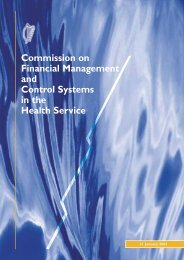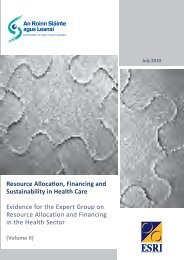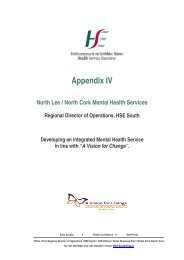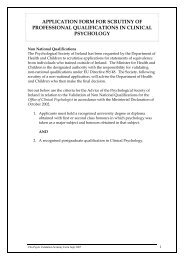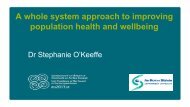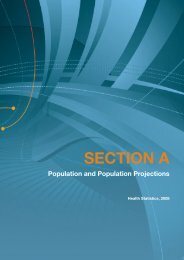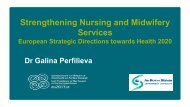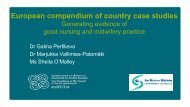Managing menopause: a review of the biomedical evidence: summary
Managing menopause: a review of the biomedical evidence: summary
Managing menopause: a review of the biomedical evidence: summary
Create successful ePaper yourself
Turn your PDF publications into a flip-book with our unique Google optimized e-Paper software.
<strong>Managing</strong> MenopauseA Review <strong>of</strong> <strong>the</strong>Bio-Medical EvidenceSummary2008
<strong>Managing</strong> MenopauseA Review <strong>of</strong> <strong>the</strong>Bio-Medical EvidenceSummary2008
<strong>Managing</strong> Menopause – A Review <strong>of</strong> <strong>the</strong> Bio-Medical Evidence – SummaryThe Women’s Health CouncilThe Women’s Health Council is a statutory body established in 1997 to advise<strong>the</strong> Minister for Health and Children on all aspects <strong>of</strong> women’s health.The mission <strong>of</strong> <strong>the</strong> Women’s Health Council is to inform and influence<strong>the</strong> development <strong>of</strong> health policy to ensure <strong>the</strong> maximum health andsocial gain for women in Ireland. Its membership is representative <strong>of</strong> a widerange <strong>of</strong> expertise and interest in women’s health.The Women’s Health Council has five functions detailed in its StatutoryInstruments:1. Advising <strong>the</strong> Minister for Health and Children on all aspects <strong>of</strong> women’shealth.2. Assisting <strong>the</strong> development <strong>of</strong> national and regional policies and strategiesdesigned to increase health gain and social gain for women.3. Developing expertise on women’s health within <strong>the</strong> health services.4. Liaising with o<strong>the</strong>r relevant international bodies which have similar functionsas <strong>the</strong> Council.5. Advising o<strong>the</strong>r Government Ministers at <strong>the</strong>ir request.The work <strong>of</strong> <strong>the</strong> Women’s Health Council is guided by three principles:• Equity based on diversity – <strong>the</strong> need to develop flexible and accessibleservices which respond equitably to <strong>the</strong> diverse needs and situations <strong>of</strong>women.• Quality in <strong>the</strong> provision and delivery <strong>of</strong> health services to all womenthroughout <strong>the</strong>ir lives.• Relevance to women’s health needs.2The Women’s Health Council
<strong>Managing</strong> Menopause – A Review <strong>of</strong> <strong>the</strong> Bio-Medical Evidence – Summary4The Women’s Health Council
Background information on <strong>the</strong> <strong>menopause</strong>Early symptoms <strong>of</strong> <strong>the</strong> <strong>menopause</strong> include:Physical/Sexual symptoms• Hot flushes & night sweats• Heart palpitations• Shortness <strong>of</strong> breath• Chest tightness• Headaches• Joint aches• Dizziness• Decreased sex drivePsychological symptoms• Mood swings• Irritability• Insomnia• Anxiety• Poor sleep pattern• Difficulty concentrating• ForgetfulnessAs time goes on, o<strong>the</strong>r symptoms may occur, <strong>the</strong>se include:• Increased frequency <strong>of</strong> passing urine• Discomfort when passing urine• Urine infections• Urinary incontinence• Vaginal dryness, discomfort, burning and itching• Dry skin and hair, and brittle nails• Loss <strong>of</strong> bone densityPsychological symptoms such as depression, mood swings, irritability, anxiety,forgetfulness and poor concentration may emerge due to hormone changes oras a result <strong>of</strong> having to cope with <strong>the</strong> physical symptoms describes above.Long term health impacts <strong>of</strong> <strong>menopause</strong>Over time, <strong>the</strong> changes in hormone production affect various parts <strong>of</strong> <strong>the</strong>body, in particular <strong>the</strong> bones, <strong>the</strong> cardiovascular system and <strong>the</strong> urogenitalsystem. Although, many women will not experience <strong>the</strong> symptoms describedbelow, <strong>the</strong> risk <strong>of</strong> developing <strong>the</strong>se symptoms increases significantly due to<strong>the</strong> fall in oestrogen levels.OsteoporosisOsteoporosis meaning “porosity <strong>of</strong> <strong>the</strong> bones” is a skeletal diseasecharacterized by low bone mass and deterioration <strong>of</strong> bone tissue. Thisincreases <strong>the</strong> risk <strong>of</strong> bone fractures. Oestrogen is important in slowing down<strong>the</strong> rate <strong>of</strong> bone breakdown. Both men and women start to loose calciumThe Women’s Health Council9
<strong>Managing</strong> Menopause – A Review <strong>of</strong> <strong>the</strong> Bio-Medical Evidence – Summaryfrom <strong>the</strong>ir bones as <strong>the</strong>y get older. However, women are much more at risk <strong>of</strong>fracture than men due to three main reasons:1. Their peak bone mass is less than that in men2. They live, on average, longer than men and so have a longer period <strong>of</strong>bone loss3. Most significantly, <strong>the</strong>ir rate <strong>of</strong> bone loss exceeds that in men once <strong>the</strong><strong>menopause</strong> is reached and oestrogen levels diminish.Women may not experience any signs or symptoms <strong>of</strong> bone loss until <strong>the</strong>yhave had a fracture resulting from a simple fall or knock. Estimates from <strong>the</strong>World Health Organization and <strong>the</strong> International Osteoporosis Foundation(Melton et al., 1992; Kanis et al., 2000) suggest that one in three women over<strong>the</strong> age <strong>of</strong> fifty have osteoporosis <strong>of</strong> <strong>the</strong> hip, spine or wrist. If this estimate isapplied to <strong>the</strong> Irish population, osteoporosis may affect over 190,000 womenaged over fifty, or approximately 9% <strong>of</strong> <strong>the</strong> total population (CSO, 2006).Cardiovascular diseaseCardiovascular disease (CVD) refers to diseases affecting <strong>the</strong> heart or bloodvessels, for example, Stroke and Coronary Heart Disease (CHD). In Ireland,between 2002 and 2006, an average <strong>of</strong> 2,382 women died each year fromischaemic heart disease (CSO, 2007). CHD is uncommon in women before<strong>the</strong> <strong>menopause</strong>, especially non-smokers. The loss <strong>of</strong> ovarian function anddrop in oestrogen levels is associated with an increased CHD risk (Stevenson,2004). Oestrogen helps to reduce cholesterol in <strong>the</strong> bloodstream and reduces<strong>the</strong> risk <strong>of</strong> hardening and clogging <strong>of</strong> <strong>the</strong> coronary arteries, and is <strong>the</strong>reforeassociated with reduced risk <strong>of</strong> heart disease in women.Urogenital symptomsThe drop in oestrogen levels that occurs during <strong>menopause</strong> results in agradual deterioration <strong>of</strong> tissues <strong>of</strong> <strong>the</strong> urinary tract and vagina. Symptomshowever, do not appear until some years after <strong>the</strong> <strong>menopause</strong>, although <strong>the</strong>ycan be particularly distressing and impair a woman’s quality <strong>of</strong> life. Womenmay experience frequent passing <strong>of</strong> water during <strong>the</strong> day or night, or stressincontinence (<strong>the</strong> involuntary leakage <strong>of</strong> urine during exercise, coughing,laughing or sneezing).10The Women’s Health Council
<strong>Managing</strong> menopausal symptoms3. <strong>Managing</strong> menopausalsymptomsThere are many different types <strong>of</strong> treatment available to relieve menopausalsymptoms. For <strong>the</strong> purpose <strong>of</strong> this <strong>review</strong> <strong>the</strong> treatments are categorised into:(i)(ii)(iii)Lifestyle modificationsPrescription <strong>the</strong>rapies (hormonal and non-hormonal)Non-prescription <strong>the</strong>rapies(i) Lifestyle modificationsLifestyle modifications such as having a healthy diet, exercising regularly,maintaining a healthy body weight, limiting alcohol consumption and notsmoking may be useful in relieving mild menopausal symptoms. The <strong>evidence</strong>to support <strong>the</strong>se lifestyle changes is presented below.Table 1 Summary <strong>of</strong> <strong>evidence</strong> for effectiveness <strong>of</strong> lifestyle modificationsLifestylemodificationHealthy dietRegular exerciseHealthy weightAlcoholSmokingSummary <strong>of</strong> <strong>evidence</strong>Risk <strong>of</strong> osteoporosis & heart disease ↑ in postmenopausalwomen, <strong>the</strong>refore a healthy diet is important. In particular,adequate calcium and vitamin D, and low salt are recommended.Although thought to be beneficial, <strong>the</strong>re is no <strong>evidence</strong> thatvitamin E is effective in relieving menopausal symptoms.Intensive, vigorous exercise may make hot flushes worse.Regular, moderate exercise may be beneficial for relievingmenopausal symptoms but fur<strong>the</strong>r good quality trials arerequired to support this.Normal healthy weight women have ↓ hot flushes comparedwith overweight women.Moderate alcohol consumption seems to have no effect onhot flushes.Drinking more than 3 units <strong>of</strong> alcohol a day, or 14 units perweek is likely to ↑ hot flushes.Active smoking is thought to ↑ <strong>the</strong> likelihood <strong>of</strong> hot flushes,although 1 large study found no ↑. Passive smoke exposureis thought to ↑ likelihood <strong>of</strong> hot flushes.The Women’s Health Council11
<strong>Managing</strong> Menopause – A Review <strong>of</strong> <strong>the</strong> Bio-Medical Evidence – Summary(ii) Prescription <strong>the</strong>rapies (hormonal andnon-hormonal)A description <strong>of</strong> <strong>the</strong> types <strong>of</strong> hormonal <strong>the</strong>rapies available and a briefdescription <strong>of</strong> <strong>the</strong> <strong>the</strong>rapies examined in this <strong>review</strong> is provided along wi<strong>the</strong>vidence <strong>of</strong> <strong>the</strong>ir effectiveness <strong>of</strong> relieving menopausal symptoms. Followingthis, <strong>the</strong> additional risks and benefits <strong>of</strong> oral oestrogen only <strong>the</strong>rapy andcombined oestrogen and progesterone <strong>the</strong>rapy are discussed.Hormone Replacement Therapy (HRT) useA survey <strong>of</strong> women across Ireland, aged 40 and over, was conducted inJanuary 2008. Of <strong>the</strong> 475 women surveyed, half claimed <strong>the</strong>y haveexperienced or are currently experiencing <strong>the</strong> <strong>menopause</strong>. Of <strong>the</strong>se women,5% were currently taking HRT, and 14% had previously taken HRT. The surveyalso showed that <strong>the</strong> majority <strong>of</strong> women (55%) used HRT for between oneand three and a half years (WHC, 2008c). Therefore, <strong>the</strong> issue <strong>of</strong> taking HRT isrelevant to a relatively small sub-section <strong>of</strong> <strong>the</strong> menopausal women.Types <strong>of</strong> HRTThere are a wide range <strong>of</strong> HRT preparations available which allow <strong>the</strong> clinicianto customize <strong>the</strong> type, dose and delivery route <strong>of</strong> <strong>the</strong> HRT to suit <strong>the</strong> needs <strong>of</strong>each woman. The two main types <strong>of</strong> HRT are oestrogen on its own andoestrogen combined with a second hormone, progestogen (similar toprogesterone). The oestrogen component <strong>of</strong> HRT replaces <strong>the</strong> oestrogen lostat <strong>the</strong> <strong>menopause</strong> and relieves menopausal symptoms. Oestrogen on its ownis given to women who have had a hysterectomy (women with <strong>the</strong>iruterus/womb removed). Women with an intact uterus are given acombination <strong>of</strong> oestrogen & progestogen HRT. Progestogen is necessary toprevent endometrial hyperplasia (thickening <strong>of</strong> <strong>the</strong> uterus) (Grady, et al., 1995).HRT can be taken by various delivery routes. The oral route is usually <strong>the</strong> firstchoice mainly as it is simple, economical and, in <strong>the</strong> long-term, can provideeffective protection for <strong>the</strong> cardiovascular system and bones. Women whocannot, or prefer not to use oral HRT, can use take HRT via transdermal routes(through <strong>the</strong> skin) such as patches, gels, nasal spray, vaginal formulations orimplants.Various HRT regimens can also be used to suit women at different stages <strong>of</strong><strong>the</strong> menopausal process. Combined oestrogen & progestogen can be taken asa sequential, cyclical, long-cycle or continuous regimen. Perimenopausalwomen (having a period within <strong>the</strong> past 12 months) can use sequentialregimens (oestrogen everyday and progesterone for <strong>the</strong> last 10-14 days <strong>of</strong>cycle), cyclical regimens (oestrogen from day 1-25 and progestin for 10-14days each month) or long-cycle regimens (oestrogen for 3 months andprogesterone in <strong>the</strong> 2nd half <strong>of</strong> <strong>the</strong> third month). These regimens will cause a12The Women’s Health Council
<strong>Managing</strong> menopausal symptomsmonthly bleed. Postmenopausal women (having last period over 12 monthsago) have <strong>the</strong> option <strong>of</strong> sequential, cyclical, long cycle or continuouscombined regimes, but most choose <strong>the</strong> “no bleed” (continuous combined)regimen with a daily dose <strong>of</strong> both hormones. Figure 2 summarises <strong>the</strong>regimens <strong>of</strong> HRT. The syn<strong>the</strong>tic steroid Tibolone is only suitable for olderwomen, over 54 years, who have had no period for at least 12 months. AsTibolone does not stimulate <strong>the</strong> uterine lining, it can be used withoutprogesterone.There are no clear guidelines on <strong>the</strong> best way to stop using HRT. Bothimmediate cessation (“cold turkey”) and gradual tapering <strong>of</strong> <strong>the</strong> dose (bylowering <strong>the</strong> dose and/or skipping progressively more days between doses)have been suggested (NAMS, 2004). The gradual discontinuation <strong>of</strong> HRTallows <strong>the</strong> individual to lower <strong>the</strong> dose until symptoms reappear, <strong>the</strong>reforeidentifying <strong>the</strong> smallest dose required for <strong>the</strong> control <strong>of</strong> menopausalsymptoms.Figure 2:Choice <strong>of</strong> HRT Regimens(adapted from RCN, 2005)Indication for HRTIntact uterus/wombHad hysterectomyLess than 1 yearsince LMP*More than 1 yearsince LMP*Oestrogen & Progestogen HRTSequential regimenorCyclical regimenorLong-cycle regimenContinuouscombinedregimenTiboloneOestrogen only+/-AndrogenLast Menstrual Period*The Women’s Health Council13
<strong>Managing</strong> Menopause – A Review <strong>of</strong> <strong>the</strong> Bio-Medical Evidence – SummaryOestrogen only <strong>the</strong>rapyOestrogen only <strong>the</strong>rapy is suitable for women without a uterus. In Europe,<strong>the</strong> most widely prescribe oestrogen is pure estradiol syn<strong>the</strong>sised from soyabeans and yams. In North America, conjugated (or blended) estrogensobtained from pregnant horses’ urine are most commonly used. Oraloestrogen can provide relief from both vasomotor symptoms and vaginalatrophy (such as vaginal dryness, irritation and itching, or pain duringintercourse) however, if relief is only required from vaginal atrophy, <strong>the</strong>noestrogen can be applied locally to <strong>the</strong> vagina to relieve symptoms (NAMS,2007). The methods <strong>of</strong> administering vaginal oestrogen include intra-vaginalcream, a vaginal ring placed high up inside <strong>the</strong> vagina, or vaginal tablet placedin <strong>the</strong> vagina.There is good <strong>evidence</strong> that shows oral oestrogen HRT to be very effective inrelieving vasomotor symptoms in menopausal women (MacLennan et al.,2004). It is well established that oestrogen <strong>the</strong>rapy is also effective in relievingurogenital symptoms (such as vaginal dryness and painful intercourse), sleepdisturbances and improving quality <strong>of</strong> life (NIH, 2005). Evidence also showsoral and transdermal oestrogen have consistent and similar effects on relievinghot flushes and may have similar adverse effects (Nelson, 2004).Local vaginal oestrogen is effective at relieving urogenital symptoms. There iscurrently inadequate data to determine whe<strong>the</strong>r women need to takeprogesterone along with locally applied vaginal oestrogen to provideprotection from endometrial cancer, although as a precaution, progesterone is<strong>of</strong>ten prescribed along with oestrogen (Sucking et al., 2006).Combined oestrogen & progestogen <strong>the</strong>rapyBecause <strong>of</strong> <strong>the</strong> increased risk <strong>of</strong> endometrial cancer with oestrogen only<strong>the</strong>rapy, all women with an intact uterus should receive combined oestrogenand progestogen HRT. Progestogen protects against <strong>the</strong> development <strong>of</strong>endometrial cancer.It is well established that combined oestrogen and progestin HRT is effective inrelieving hot flushes. A significant reduction <strong>of</strong> 75% in <strong>the</strong> weekly frequency<strong>of</strong> hot flushes was found for women taking HRT compared to those taking aplacebo (MacLennan et al., 2004). A <strong>review</strong> <strong>of</strong> <strong>the</strong> <strong>evidence</strong> suggests thatcombined oestrogen and progesterone HRT might be more effective inrelieving hot flushes due to <strong>the</strong> additional beneficial effects <strong>of</strong> progesterone,although this is not conclusive (MacLennan et al., 2004).14The Women’s Health Council
<strong>Managing</strong> menopausal symptomsThere is no <strong>evidence</strong> to indicate whe<strong>the</strong>r one HRT product or regime issuperior to ano<strong>the</strong>r for relieving menopausal symptoms (ICSI, 2006; NAMS,2004). In clinical practice, each woman absorbs oral oestrogen differently(Helton, 1977). Therefore, it is important to find <strong>the</strong> most suitable HRT doseand regimen for each individual woman so that <strong>the</strong>re is a balance betweenrelief from menopausal symptoms and any oestrogenic side effects(MacLennan et al., 2004). In general, women are recommended to use <strong>the</strong>lowest HRT dose for <strong>the</strong> shortest time necessary to control menopausalsymptoms (MHRA, 2007a; ICSI, 2006; AACE, 2006).Progesterone only <strong>the</strong>rapyAlthough progesterone is primarily used in combination with oestrogen toprovide protection against endometrial cancer, progesterone used alone canprovide relief from hot flushes if <strong>the</strong> benefit-risk pr<strong>of</strong>ile is acceptable to <strong>the</strong>woman. There is good <strong>evidence</strong> to show that progesterone only <strong>the</strong>rapy iseffective in relieving hot flushes (NAMS, 2004). However, concerns haverecently arisen over whe<strong>the</strong>r progestogen only <strong>the</strong>rapy can increase <strong>the</strong> risk <strong>of</strong>breast cancer (RCOG, 2006). Considering this, it is probably inappropriate totreat women who have an increased risk <strong>of</strong> breast cancer with progestogens(RCOG, 2006). In Ireland, progesterone only <strong>the</strong>rapy is not generallyprescribed to treat menopausal symptoms.Tibolone (“Livial”)Livial tablets contain <strong>the</strong> active ingredient tibolone, which is a syn<strong>the</strong>tic steroidthat has some oestrogen-, progesterone- and testosterone-like effects. It hasbeen extensively researched and is licensed in Europe for <strong>the</strong> relief <strong>of</strong>menopausal symptoms, including hot flashes, vaginal atrophy and reducedlibido. Tibolone, like HRT, prevents bone loss in postmenopausal women withand without osteoporosis (Sturdee, 2004). It was one <strong>of</strong> <strong>the</strong> first “no period”regimens developed and is most suited to post menopausal women (Lumsden,2004; Sturdee, 2004).The effectiveness and safety <strong>of</strong> tibolone is comparable to HRT. As tiboloneseems not to stimulate <strong>the</strong> breast, it may potentially be useful in treatingmenopausal symptoms in woman with breast cancer (MacLennan, 2007).However, <strong>the</strong>re is currently insufficient <strong>evidence</strong> to make any firm conclusionson <strong>the</strong> risk <strong>of</strong> tibolone to <strong>the</strong> breast. Tibolone is only suitable for olderwomen over 54 years who have had no period for at least 12 months(Lumsden, 2004; Sturdee, 2004).The Women’s Health Council15
<strong>Managing</strong> Menopause – A Review <strong>of</strong> <strong>the</strong> Bio-Medical Evidence – SummaryOral contraceptives (OCs)Women who need contraception as well as hormone <strong>the</strong>rapy to relieve hotflashes (such as women with premature ovarian failure and experiencingpremature <strong>menopause</strong>) may be prescribed <strong>the</strong> combined oestrogen andprogesterone OC pill (BMS, 2007). Premature <strong>menopause</strong> affects about 1%<strong>of</strong> women (RCN, 2005). All women with a premature <strong>menopause</strong> shouldnormally be <strong>of</strong>fered HRT until <strong>the</strong> average age <strong>of</strong> <strong>menopause</strong>.There is a lack <strong>of</strong> studies conducted on <strong>the</strong> effectiveness <strong>of</strong> oral contraceptivesfor relieving menopausal symptoms in women with premature <strong>menopause</strong>.The oestrogen and progesterone found in OCs is generally stronger whencompared to HRT (NAMS, 2004). This is likely to increase <strong>the</strong> effectiveness <strong>of</strong>OCs in relieving menopausal symptoms.Additional benefits & associated risks <strong>of</strong> HRTMenopausal symptoms do not last forever, and treatment for 2-4 years isnormally sufficient (Sturdee, 2004). Some women need to use HRT for longerto relieve menopausal symptoms and take advantage <strong>of</strong> <strong>the</strong> benefits <strong>of</strong> HRT.The safety <strong>of</strong> HRT largely depends on <strong>the</strong> age <strong>of</strong> <strong>the</strong> women. TheInternational Menopausal Society states that women younger than 60 yearsold should not be concerned about <strong>the</strong> safety pr<strong>of</strong>ile <strong>of</strong> HRT (IMS, 2007).HRT has received widespread media attention over <strong>the</strong> last few years, much <strong>of</strong>it negative criticism. This led to many women avoiding HRT. The initialfindings published from <strong>the</strong> large Women’s Health Initiative (WHI) studiesreported that combined HRT increased <strong>the</strong> risk <strong>of</strong> CHD, stroke, blood clots andbreast cancer. Findings published from <strong>the</strong> large Million Women Study (MWS)reported that HRT increased <strong>the</strong> risk <strong>of</strong> breast cancer and ovarian cancer.However, some limitations <strong>of</strong> <strong>the</strong> methods and analyses used in <strong>the</strong>se studieshave been identified. For example, <strong>the</strong> WHI studies involved mainly olderwomen, many <strong>of</strong> whom were currently taking or had previously taken HRT.The findings, <strong>the</strong>refore, are not applicable to younger women who have neverhad HRT.To summarise, <strong>the</strong> benefits <strong>of</strong> HRT include protection from osteoporoticfracture and colon cancer, as well as providing effective relief frommenopausal symptoms. The <strong>evidence</strong> suggests using HRT increases <strong>the</strong> risk <strong>of</strong>breast cancer, ovarian cancer, blood clot and stroke. The effect <strong>of</strong> HRT onCHD is currently unclear, although it seems that <strong>the</strong> risk <strong>of</strong> CHD is reduced inyounger women (less than 60 years) and women beginning HRT near<strong>menopause</strong> (within 10 years).16The Women’s Health Council
<strong>Managing</strong> menopausal symptomsThe safety <strong>of</strong> HRT largely depends on <strong>the</strong> age <strong>of</strong> <strong>the</strong> women. Evidence for <strong>the</strong>risks <strong>of</strong> HRT in women who have premature <strong>menopause</strong> is limited, althoughaverage (baseline) risk <strong>of</strong> adverse events in <strong>the</strong>se younger women is very lowand <strong>the</strong> balance <strong>of</strong> benefits and risks may <strong>the</strong>refore be more favourable thanin older women (MHRA, 2007a).Data from new research and fur<strong>the</strong>r analyses <strong>of</strong> data obtained in previousstudies show that, for most women, <strong>the</strong> potential benefits far outweigh <strong>the</strong>risks when HRT is initiated within a few years <strong>of</strong> <strong>the</strong> <strong>menopause</strong>. Two clinicaltrials currently ongoing, KEEPS (Kronos Early Estrogen Prevention Study)(KEEPS, 2007) and ELITE (Early versus Late Intervention Trial with Estradiol)(ELITE, 2007) will, in a few years time, provide valuable <strong>evidence</strong> regarding <strong>the</strong>risks and benefits <strong>of</strong> using oral or transdermal HRT, and <strong>the</strong> age <strong>of</strong> initiatingHRT.The Medicines and Healthcare products Regulatory Agency (MHRA) conducteda comprehensive <strong>review</strong> on medicines for women’s health at <strong>the</strong>ir meeting inJuly 2007 and published updated safety advice on HRT after considering <strong>the</strong>most recent <strong>evidence</strong> (MHRA, 2007b). A <strong>summary</strong> <strong>of</strong> <strong>the</strong> estimated risks andbenefits, using <strong>the</strong> data provided by <strong>the</strong> MHRA, are shown in Table 2a-c.The Women’s Health Council17
<strong>Managing</strong> Menopause – A Review <strong>of</strong> <strong>the</strong> Bio-Medical Evidence – SummaryTable 2a Summary <strong>of</strong> risks and benefits <strong>of</strong> HRT: cancer risk(adapted from MHRA, 2007b)Age range(years)Time(years)Number <strong>of</strong> womenper 1000 expectedto develop cancer*Number <strong>of</strong> women per1000 using HRT expected todevelop cancer †Fur<strong>the</strong>r explanationOestrogenonly HRTOestrogen &progestogenHRTBreast cancer50-5960-6950-5960-695 10 12 165 15 18 2410 20 26 4410 30 39 66Risk is lower with oestrogen only HRT and whenHRT is used for around 5 years or less. The risk<strong>of</strong> breast cancer approximately doubles withlong-term use <strong>of</strong> combined HRT.Endometrial cancer50-5960-6950-5960-695 2 6 25 3 9 310 4 26 410 6 54 6Women with a uterus use combined HRT asprogesterone greatly reduces risk. The number <strong>of</strong>cases <strong>of</strong> endometrial cancer increases approximately3 times when using oestrogen only HRT for 5 yearsand 9 times when used for 10 years.Ovarian cancer50-5960-6950-5960-695 2 2 25 3 3 310 4 5 510 6 8 8The increased risk associated with HRT is verysmall, even with long-term HRT use <strong>the</strong>increased risk is relatively small.* Background incidence from ‘never users’ in <strong>the</strong> Million Women Study for breast cancer, and <strong>the</strong> International Agency for Research on Cancer (IARC) for ovarian & endometrial cancer.† Best estimate based on relative risk derived from meta-analyses <strong>of</strong> RCTs and observational studies for endometrial and ovarian cancer, and meta-analyses <strong>of</strong> RCTs and observational studies in Europe forbreast cancer.18The Women’s Health Council
<strong>Managing</strong> menopausal symptomsTable 2b Summary <strong>of</strong> risks and benefits <strong>of</strong> HRT: cardiovascular effect(adapted from MHRA, 2007b)Age range(years)Time(years)Number <strong>of</strong> womenper 1000 expectedto experiencecardiovasculareffect*Number <strong>of</strong> women per 1000using HRT expected toexperience cardiovascular effect †Oestrogenonly HRTOestrogen &progestogenHRTFur<strong>the</strong>r explanationVenousthromboembolism(VTE)50-5960-695 5 7 125 8 10 18The risk is highest with combined HRT. Theincreased risk when using combined HRT is justover double <strong>of</strong> that compared with not using HRT.Stroke50-5960-695 4 5 55 9 12 12The increased risk <strong>of</strong> stroke is relatively small. Theincreased risk is similar for women <strong>of</strong> all agebetween 50 and 69 years, although <strong>the</strong> expectednumber <strong>of</strong> women experiencing stroke increaseswith age.Coronary heartdisease (CHD) O OP 50-5960-6970-795 14 9 14 95 31 18 31 185 44 29 44 44Younger women, and women who start HRTaround <strong>the</strong> time <strong>of</strong> <strong>menopause</strong> may have areduced risk <strong>of</strong> CHD. Women aged over 70 whotake combined HRT have a 50% increased risk <strong>of</strong>CHD.* Background incidence from Hospital Admissions in England (HES) for VTE & stroke and <strong>the</strong> Women’s Health Initiative (WHI) for CHD.† Best estimate based on relative risk derived from meta-analyses <strong>of</strong> RCTs and observational studies for VTE, meta-analyses <strong>of</strong> RCTs for stroke, and <strong>the</strong> WHI trial for CHD. Estimates from placebo groups from <strong>the</strong> conjugated equine oestrogens (CEE) and CEE + medroxyprogesterone placebo arms <strong>of</strong> WHI trial.O=oestrogen, OP=oestrogen and progestogen.The Women’s Health Council19
<strong>Managing</strong> Menopause – A Review <strong>of</strong> <strong>the</strong> Bio-Medical Evidence – SummaryTable 2c Summary <strong>of</strong> risks and benefits <strong>of</strong> HRT: benefits**(adapted from MHRA, 2007b)Age range(years)Time(years)Number <strong>of</strong> womenper 1000 expectedto experiencecolorectal cancerNumber <strong>of</strong> women per 1000using HRT expected toexperience colorectal canceror femur fracture or femur fracture Oestrogenonly HRTColorectal cancer O OP50-595 6 3 6 360-695 10 8 10 8Oestrogen &progestogenHRTFracture <strong>of</strong> femur O OP50-595 0.5 1.5 0.6 1.560-695 5.5 5.5 3.5 5.5**Menopausal symptom relief is not included in this table, but is a key benefit <strong>of</strong> HRT and will play a major part in <strong>the</strong> decision to prescribe HRT. Incidence estimated from placebo groups from <strong>the</strong> conjugated equine oestrogens (CEE) and CEE + medroxyprogesterone placebo arms <strong>of</strong> WHI trial.O=oestrogen, OP=oestrogen and progestogen.Fur<strong>the</strong>r explanationEvidence suggests combined HRT has a protectiveeffect against colorectal cancer. It is estimated toreduce risk by 10%, although in terms <strong>of</strong> number<strong>of</strong> cases per 1000, this reduction is negligible.Both oestrogen only HRT and combined HRTreduce <strong>the</strong> risk <strong>of</strong> osteoporotic fracture. A 30-40% reduction <strong>of</strong> fracture is estimated fromtaking HRT.20The Women’s Health Council
<strong>Managing</strong> menopausal symptomsPrescription <strong>the</strong>rapies (non-hormonal)For women suffering from hot flashes who do not want to use HRT, or whoare advised not to use HRT (women who have breast cancer or at high risk <strong>of</strong>gynaecological cancers), non-hormonal prescription drugs may provide aneffective option.Some prescription anti-depressants and <strong>the</strong> anti-convulsant drug, gabapentin,may provide some relief from hot flashes. While <strong>the</strong>se may be prescribed ino<strong>the</strong>r countries for relieving menopausal symptoms, <strong>the</strong>y are currently notlicensed in Ireland for this purpose.Clonidine is an anti-hypertensive drug that may also be used to relieve hotflushes. Clonidine causes blood vessels to widen increasing blood flow. InIreland, clonidine is available as “Dixarit” tables. Dixarit is prescribed primarilyto treat attacks <strong>of</strong> migraine and similar types <strong>of</strong> headache, although it is alsolicensed for <strong>the</strong> treatment <strong>of</strong> menopausal hot flushes. Dixarit may initiallycause tiredness or a dry mouth, and o<strong>the</strong>r side effects such as dizziness,feeling sick and restlessness at night have also been reported (Nelson et al.,2006). The <strong>evidence</strong> suggests that although clonidine is effective in relievinghot flushes (Pandya et al., 2000), <strong>the</strong> effect may only be moderate (Goldberget al., 1994).Table 3Summary <strong>of</strong> <strong>evidence</strong> on prescription <strong>the</strong>rapiesHot flushesVaginal atrophyOestrogen only <strong>the</strong>rapy✓✓Combined oestrogenand progesterone <strong>the</strong>rapyProgesterone only <strong>the</strong>rapy✓✓✓✗Tibolone✓✓Oral contraceptivesClonidine✓✓✓✗✓✗Good scientific <strong>evidence</strong> <strong>of</strong> a beneficialeffect for menopausal womenNo <strong>evidence</strong> <strong>of</strong> a beneficial effect formenopausal women21The Women’s Health Council
<strong>Managing</strong> Menopause – A Review <strong>of</strong> <strong>the</strong> Bio-Medical Evidence – Summary(iii) Non-prescription <strong>the</strong>rapiesThe non-prescription <strong>the</strong>rapies examined in this <strong>review</strong> include herbal <strong>the</strong>rapies,phytoestrogens and complementary <strong>the</strong>rapies. A description <strong>of</strong> <strong>the</strong>se <strong>the</strong>rapies isprovided below, followed by a <strong>summary</strong> <strong>of</strong> <strong>the</strong> <strong>evidence</strong> on <strong>the</strong>ir effectiveness onrelieving menopausal symptoms.Herbal <strong>the</strong>rapiesAlthough herbal medicine has been used for centuries to relieve a wide range <strong>of</strong>ailments, <strong>the</strong>re remains very little scientific <strong>evidence</strong> <strong>of</strong> <strong>the</strong>ir efficacy, safety and littlepro<strong>of</strong> to support <strong>the</strong> claims made for <strong>the</strong>se remedies. Like all medicines, herbal<strong>the</strong>rapies may cause side effects, and <strong>the</strong>re is also some concern over <strong>the</strong> interaction<strong>of</strong> some herbal remedies with o<strong>the</strong>r treatments. A <strong>summary</strong> <strong>of</strong> herbal <strong>the</strong>rapiescommonly used to relieve menopausal symptoms is presented in <strong>the</strong> table below.Table 4: Description <strong>of</strong> herbal <strong>the</strong>rapiesHerbal <strong>the</strong>rapy Possible side effects Notes Commonly used for:Black CohoshVery few reported.Avoid if have liver disease, oruse alcohol heavily. Caution iftaking blood pressuretreatment.Hot flushesSleep disturbancesVaginal drynessDepressionAnxietyDong QuaiCan make skin sensitiveto <strong>the</strong> sun & cause rash.Avoid combining with bloodthinning drugs (for e.g.Warfarin, Asprin).Hot flushesEvening primroseoilVery few reported.Contains gamma-linolenicacid, an essential fatty acid.Breast painVaginal drynessGinsengGenerally well tolerated.Most common sideeffect is inability tosleep.May lower blood sugar levels,so caution advised if diabetic.Avoid with blood thinning orclotting medication.ConcentrationDepressionLibidoSense <strong>of</strong> well-beingGinkgoVery few reported.Avoid combining with bloodthinning drugs (for e.g.Warfarin, Asprin)DepressionFatigueMemoryValerianVery rare, but womenwho use it for longperiods may developheadaches, insomnia oragitationMay have interactions withalcohol & some prescriptionmedicines. Should not bestopped suddenlyAnxietyMood swingsSleep problemsWild YamGenerally well tolerated.Very rare allergicreactions can occur.No interactions with o<strong>the</strong>r Increasing energyprescription drugs have been Libidoreported.Menopausal arthritisOsteoporosis VaginaldrynessThe Women’s Health Council22The Women’s Health Council
<strong>Managing</strong> menopausal symptomsPhytoestrogensPhytoestrogens are naturally occurring oestrogen-like compounds obtainedfrom plants. One <strong>of</strong> <strong>the</strong> main dietary groups <strong>of</strong> phytoestrogens is is<strong>of</strong>lavones,which are found in beans, pulses, lentils, chickpeas, t<strong>of</strong>u and soy-basedproducts. The Japanese diet contains a high level <strong>of</strong> phytoestrogens. It isthought that this is why very few Japanese women suffer from hot flushesduring <strong>the</strong> <strong>menopause</strong>. Two common sources <strong>of</strong> is<strong>of</strong>lavones are red cloverand soy.There is a lack <strong>of</strong> <strong>evidence</strong> showing red clover to have an effect in relievinghot flushes and <strong>the</strong> <strong>evidence</strong> on <strong>the</strong> effectiveness <strong>of</strong> dietary soy and soyextracts is inconclusive. Soy foods have been consumed for centuries and areconsidered safe, however, soy extracts in tablets or capsules, and foodsfortified with is<strong>of</strong>lavones may contain high levels <strong>of</strong> isolated is<strong>of</strong>lavones, <strong>the</strong>long-term effects <strong>of</strong> which are not known (NAMS, 2004).Complementary <strong>the</strong>rapiesA wide range <strong>of</strong> complementary <strong>the</strong>rapies can be used to relieve short-termmenopausal symptoms. The <strong>the</strong>rapies examined in this <strong>review</strong> wereacupuncture, homeopathy, reflexology and aroma<strong>the</strong>rapy. O<strong>the</strong>rcomplementary <strong>the</strong>rapies may also be used, although <strong>the</strong>re is a lack <strong>of</strong>scientific <strong>evidence</strong> on <strong>the</strong>ir benefit to women suffering from menopausalsymptoms.The Women’s Health Council23
<strong>Managing</strong> Menopause – A Review <strong>of</strong> <strong>the</strong> Bio-Medical Evidence – SummaryTable 5Summary <strong>of</strong> <strong>evidence</strong> on non-prescription <strong>the</strong>rapiesHot flushesMood (anxiety/depression)MemoryBlack cohosh✗✓✗Ginseng✗✓✗Ginkgo✗✗✓Dong quai✗✗✗Evening primrose oil✗✗✗Valerian✗✗✗Wild yam✗✗✗Red clover is<strong>of</strong>lavones?✗✗Soy is<strong>of</strong>lavones?✗✗AcupunctureHomeopathy??✗✗✗✗✓Some scientific <strong>evidence</strong> <strong>of</strong> a beneficial effectfor menopausal women (<strong>the</strong> <strong>evidence</strong> isgenerally quite weak & <strong>of</strong> low quality)ReflexologyAroma<strong>the</strong>rapy✗✗✗✗✗✗✗?No <strong>evidence</strong> <strong>of</strong> a beneficial effect formenopausal womenInconclusive <strong>evidence</strong>24The Women’s Health Council
Conclusions4. ConclusionsScientific knowledge and <strong>evidence</strong> in this field is constantly evolving. The<strong>evidence</strong> summarised in this <strong>review</strong> presents <strong>the</strong> current consensus. Allinterventions to relieve menopausal symptoms should be individually tailored to<strong>the</strong> specific needs and concerns <strong>of</strong> each woman, and designed to provide anoptimal quality <strong>of</strong> life.Lifestyle modifications should be considered as <strong>the</strong> first step in menopausalsymptom relief and disease prevention. All women should be encouraged tohave a healthy lifestyle as this is important for general health and well-being aswell as beneficial to women suffering from mild menopausal symptoms.The <strong>menopause</strong> is a natural event in every woman’s life and many womenexperience very few or mild symptoms. For women who do experienceadverse health effects during <strong>the</strong> <strong>menopause</strong>, only a small proportion will useHRT. For relief <strong>of</strong> hot flushes and vaginal dryness, HRT remains <strong>the</strong> mosteffective pharmacologic intervention. As well as providing effective relief frommenopausal symptoms, <strong>the</strong> benefits <strong>of</strong> HRT include protection fromosteoporotic fracture and colon cancer. The <strong>evidence</strong> suggests using HRTincreases <strong>the</strong> risk <strong>of</strong> breast cancer, ovarian cancer, blood clot and CVD.Current <strong>evidence</strong> suggests that <strong>the</strong> risk <strong>of</strong> CHD is reduced in younger women(less than 60 years) and women beginning HRT near <strong>menopause</strong> (within 10years). Ongoing trials will, in a few years time, provide valuable <strong>evidence</strong>regarding <strong>the</strong> risks and benefits <strong>of</strong> using oral or transdermal HRT, and <strong>the</strong> age<strong>of</strong> initiating HRT.An individual risk pr<strong>of</strong>ile should be conducted for every woman consideringHRT. The decision to use HRT should be a joint one between a woman andher doctor, with consideration to her need for treatment, her age, history, riskfactors and personal preferences. For all women, <strong>the</strong> lowest effective doseshould be used for <strong>the</strong> shortest time. The need to continue HRT should be<strong>review</strong>ed every 6 to 12 months taking into consideration <strong>the</strong> change inbalance <strong>of</strong> risks and benefits.For women who cannot, or prefer not to use HRT, <strong>the</strong>re are variousalternatives to consider. The <strong>evidence</strong> suggests that <strong>the</strong>se alternatives provide,at best, moderate relief from menopausal symptoms. The <strong>evidence</strong> does notsupport <strong>the</strong> use <strong>of</strong> complementary <strong>the</strong>rapies in relieving menopausalsymptoms. However, as complementary <strong>the</strong>rapies generally work holistically,<strong>the</strong>y may benefit <strong>the</strong> general health and well-being <strong>of</strong> some women.The increasing volume <strong>of</strong> <strong>evidence</strong> and choice <strong>of</strong> treatments for relievingmenopausal symptoms makes <strong>the</strong> decision over treatment choice morechallenging for women. Clear, up-to-date and easily accessible information isvital to enable women to make informed choices on menopausal treatments.The Women’s Health Council25
<strong>Managing</strong> Menopause – A Review <strong>of</strong> <strong>the</strong> Bio-Medical Evidence – Summary5. ReferencesAACE Menopause Guidelines Revision Task Force (2006). "AmericanAssociation <strong>of</strong> Clinical Endocrinologists medical guidelines for clinical practicefor <strong>the</strong> diagnosis and treatment <strong>of</strong> <strong>menopause</strong>." Endocrine Practice 12(3):315-37.British Menopause Society (2007). Premature Menopause: British MenopauseSociety Council Consensus Statement. Buckinghamshire, British MenopauseSociety. From: http://www.<strong>the</strong>bms.org.uk/statementcontent.php?id=3.Central Statistics Office (2006). Vital Statistics: Fourth quarterly and yearly<strong>summary</strong>. Dublin, Central Statistics Office.Central Statistics Office (2007). "Central Statistics Office Website."January 28, 2007. From: http://www.cso.ie/.RetrievedELITE (2007). "Early versus Late Intervention Trial with Estridiol." From:http://www.usc.edu/schools/medicine/research/centers_programs/aru/elite.html.Goldberg, R. M., C. L. Loprinzi, et al. (1994). "Transdermal clonidine forameliorating tamoxifen-induced hot flashes." J Clin Oncol 12(1): 155-8.Grady, D., T. Gebrretsadik, et al. (1995). "HRT and endometrial cancer risk: Ameta-analysis." Obstetric Gynaecology 85(2): 304-13.Helton, E. D. and J. W. Goldzieher (1977). "The pharmacokinetics <strong>of</strong> ethynylestrogens: A <strong>review</strong>." Contraception 15(3): 255-84.Institute for Clinical Systems Improvement (2006). Menopause and HormoneTherapy (HT): Collaborative decision-making and management. Bloomington,Minnesota, ICSI. From:http://www.icsi.org/guidelines_and_more/guidelines__order_sets___protocols/womens_health/.Kanis, J. A., O. Johnell, et al. (2000). "Long-term risk <strong>of</strong> osteoporotic fracturein Mälmo." Osteoporosis Int 11(8): 669-74.KEEPS (2007) "Kronos Early Estrogen Prevention Study." From:http://www.keepstudy.org/5/18/contact_us.html.26The Women’s Health Council
ReferencesLumsden, M. A. (2004). “Hormone Replacement Therapy: Regimen and routes<strong>of</strong> administration”. In: Critchley, H., A. Gebbie. and V. Beral. Menopause andHormone Replacement. London, Royal College <strong>of</strong> Obstetricians andGynaecologists.MacLennan, A. H., J. L. Broadbent, et al. (2004). "Oral oestrogen andcombined oestrogen/progestogen <strong>the</strong>rapy versus placebo for hot flushes."Cochrane Database <strong>of</strong> Systematic Reviews (Issue 4).MacLennan, A. H. and D. W. Sturdee (2007). "Long-term trials <strong>of</strong> HRT forcardioprotection: Is this as good as it gets?" Climacteric 10: 1-4.Medicines & Healthcare products Regulatory Agency (MHRA) (2007a).Hormone-replacement <strong>the</strong>rapy: Safety update. UK Public Assessment Report.London, MHRA. From:http://www.mhra.gov.uk/home/idcplg?IdcService=SS_GET_PAGE&nodeId=230.Medicines & Healthcare products Regulatory Agency (MHRA). (2007b)."Hormone-replacement <strong>the</strong>rapy: Updated advice." Drug Safety Update 1(2):2-4.Melton, L. J., E. A. Chrischilles, et al. (1992). "Perspective: How many womenhave osteoporosis?" J Bone Miner Res 7(9): 1005-10.NAMS (2007). "The role <strong>of</strong> local vaginal estrogen for treatment <strong>of</strong> vaginalatrophy in postmenopausal women: 2007 position statement <strong>of</strong> The NorthAmerican Menopause Society." Menopause 14(3): 357-69.NAMS (2004). "Treatment <strong>of</strong> <strong>menopause</strong>-associated vasomotor symptoms:Position statement <strong>of</strong> The North American Menopause Society." Menopause11(1): 11-33.Nelson, H. D. (2004). "Commonly used types <strong>of</strong> postmenopausal estrogen fortreatment <strong>of</strong> hot flashes." JAMA 291(13): 1610-20.Nelson, H. D., K. K. Vesco, et al. (2006). "Nonhormonal <strong>the</strong>rapies formenopausal hot flashes." JAMA 295(17): 2057-71.NIH State-<strong>of</strong>-<strong>the</strong>-Science Panel (2005). National Institutes <strong>of</strong> Health State-<strong>of</strong><strong>the</strong>-ScienceConference Statement on management <strong>of</strong> <strong>menopause</strong>-relatedsymptoms. 22: 1-38. From: http://consensus.nih.gov/2005/2005MenopausalSymptomsSOS025PDF .pdf.The Women’s Health Council27
<strong>Managing</strong> Menopause – A Review <strong>of</strong> <strong>the</strong> Bio-Medical Evidence – SummaryPandya, K. J., G. R. Morrow, et al. (2005). "Gabapentin for hot flashes in 420women with breast cancer: A randomised double-blind placebo-controlledtrial." Lancet 366(9488): 818-24.Porter, M., G. Penney, et al. (1996). "A population based survey <strong>of</strong> women'sexperience <strong>of</strong> <strong>the</strong> <strong>menopause</strong>." Br J Obstet Gynaecol 103: 1025-8.Royal College <strong>of</strong> Nursing (2005). Women's health and <strong>the</strong> <strong>menopause</strong>: RCNguidance for nurses, midwives and health visitors. London, Royal College <strong>of</strong>Nursing. From:http://www.rcn.org.uk/publications/pdf/WomensHealthAndTheMenopause.pdf.Royal College <strong>of</strong> Obstetrics and Gynecology (2006). Alternatives to HRT formanagement <strong>of</strong> symptoms <strong>of</strong> <strong>the</strong> <strong>menopause</strong>. Scientific Advisory Committeeopinion paper 6. London, Royal College <strong>of</strong> Obstetrics and Gynecology. From:http://www.rcog.org.uk/index.asp?PageID=1561.Stevenson, J. C. (2004). “Metabolic effects <strong>of</strong> <strong>the</strong> <strong>menopause</strong> and hormonereplacement <strong>the</strong>rapy”. In: Critchley, H., A. Gebbie and V. Beral. Menopauseand Hormone Replacement. London, Royal College <strong>of</strong> Obstetrics andGynaecology.Sturdee, D. W. (2004). The Facts <strong>of</strong> Hormone Therapy for MenopausalWomen. London, The Par<strong>the</strong>non Publishing Group.Suckling, J., A. Lethaby, et al. (2006). "Local oestrogen for vaginal atrophy inpostmenopausal women." Cochrane Database <strong>of</strong> Systematic Reviews (Issue 4).WHC (Women’s Health Council) (2008a). <strong>Managing</strong> Menopause: A Review <strong>of</strong><strong>the</strong> Bio-Medical Evidence. Dubin, The Women’s Health Council.WHC (Women’s Health Council) (2008b). Public Attitudes to <strong>the</strong> Menopause:Omnibus Survey. Dublin, The Women's Health Council [survey undertaken byMillward Brown IMS, Dublin]WHO (1996). Research on <strong>the</strong> Menopause in <strong>the</strong> 90s. Technical Report Series866. Geneva, World Health Organization.28The Women’s Health Council
The Women's Health CouncilBlock D, Irish Life Centre, Abbey Street Lwr.,Dublin 1Telephone: 353 1 878 3777Fax: 353 1 878 3710Email: info@whc.iewww.whc.ie



